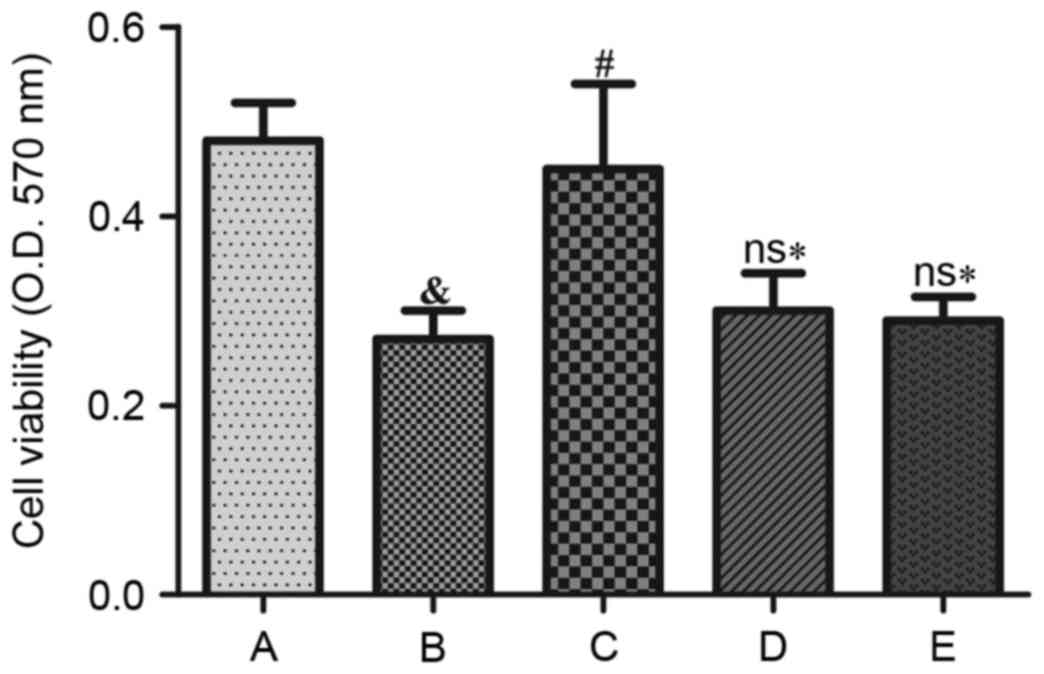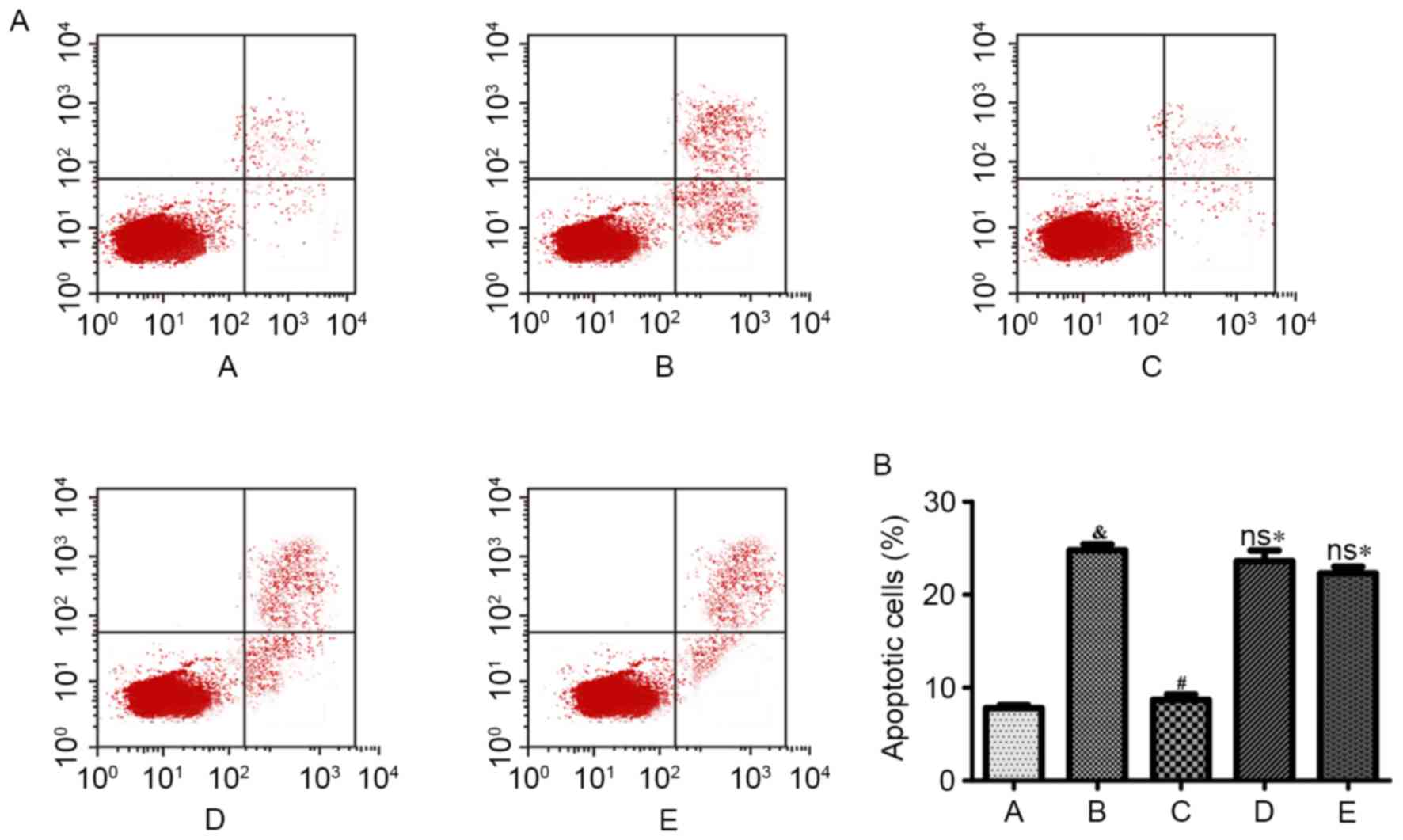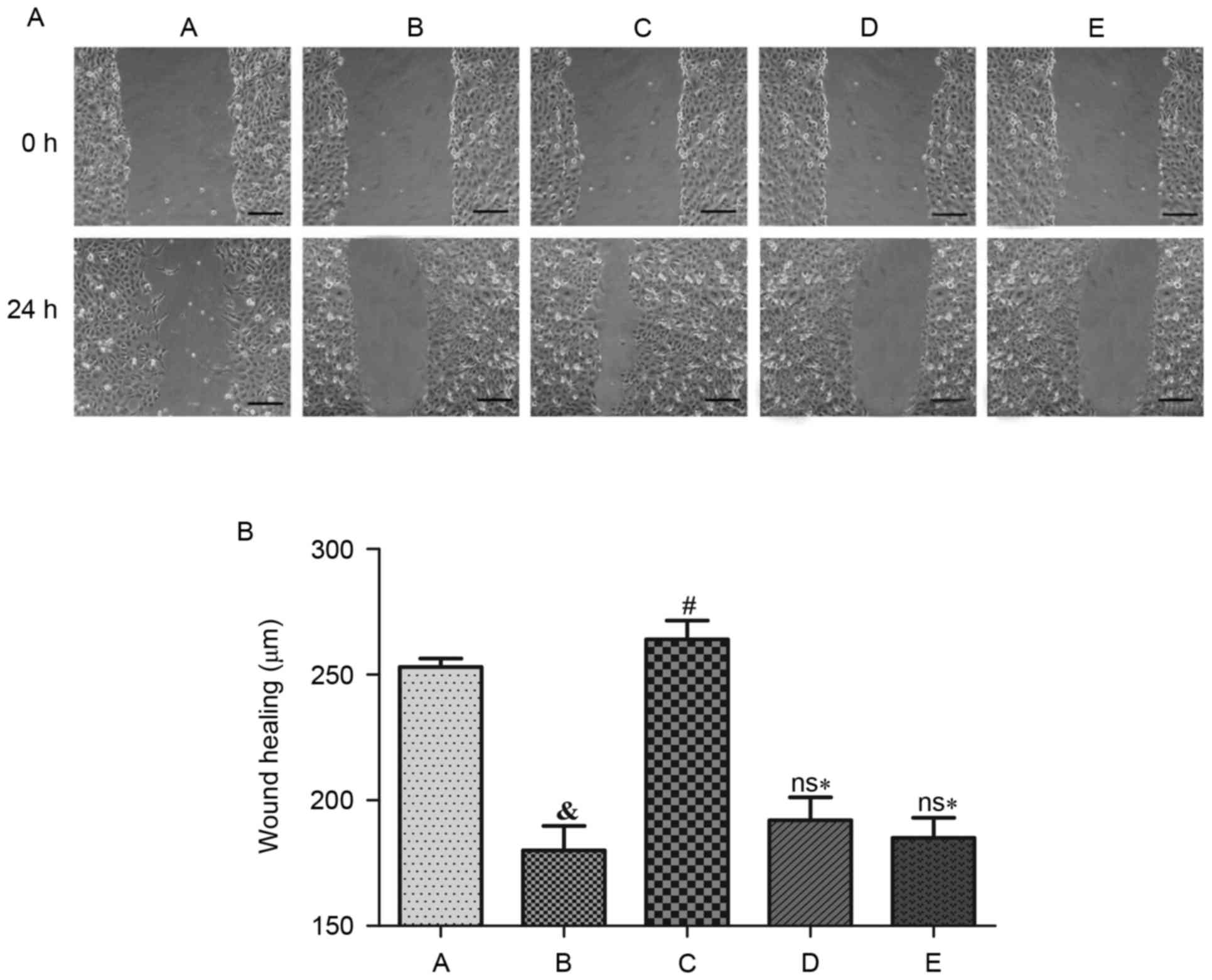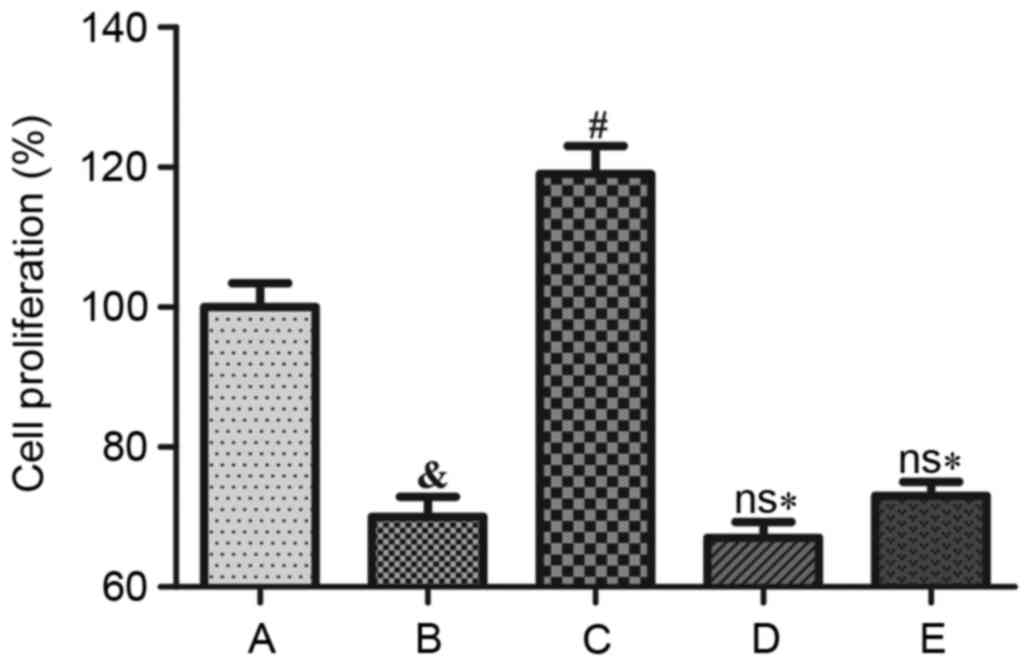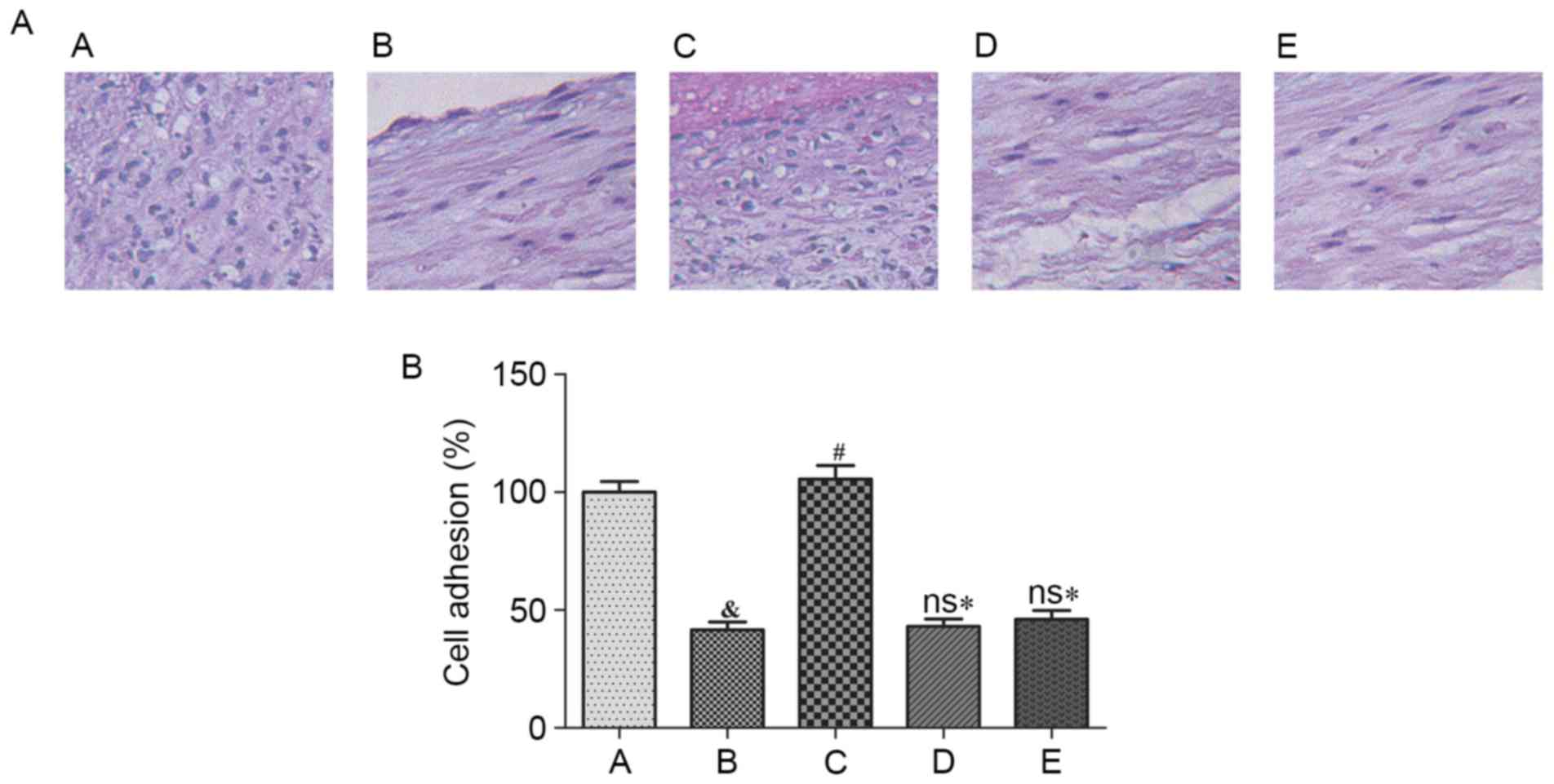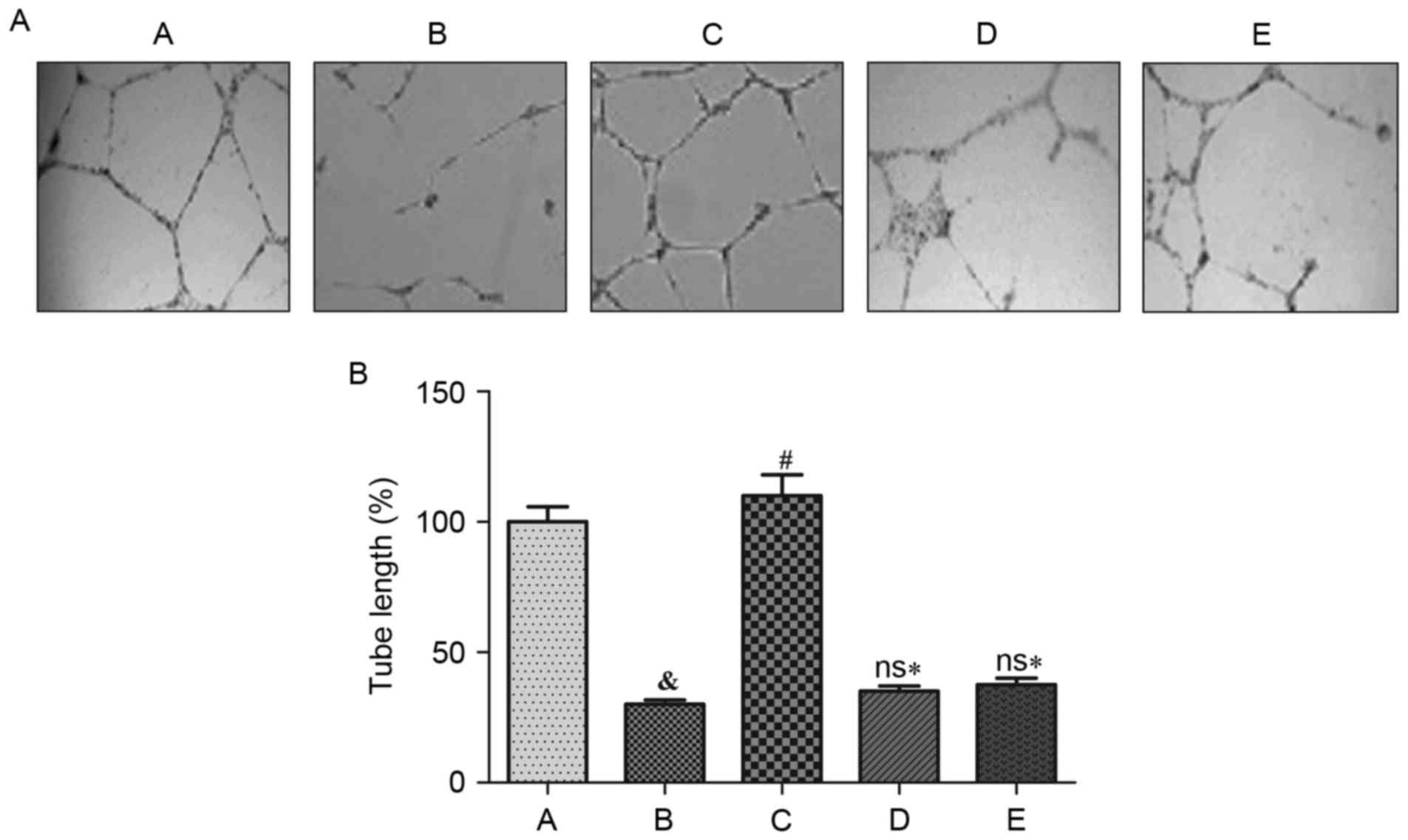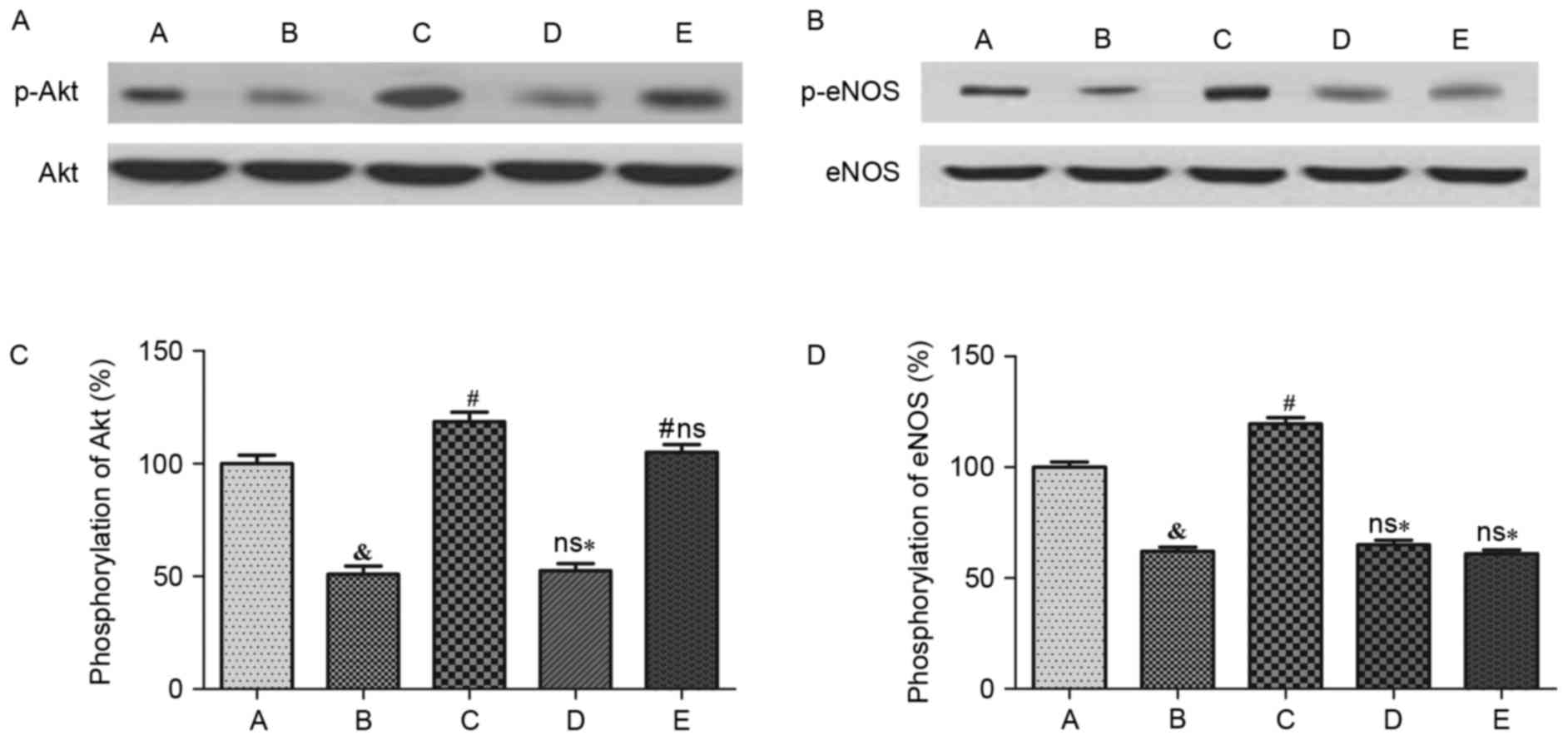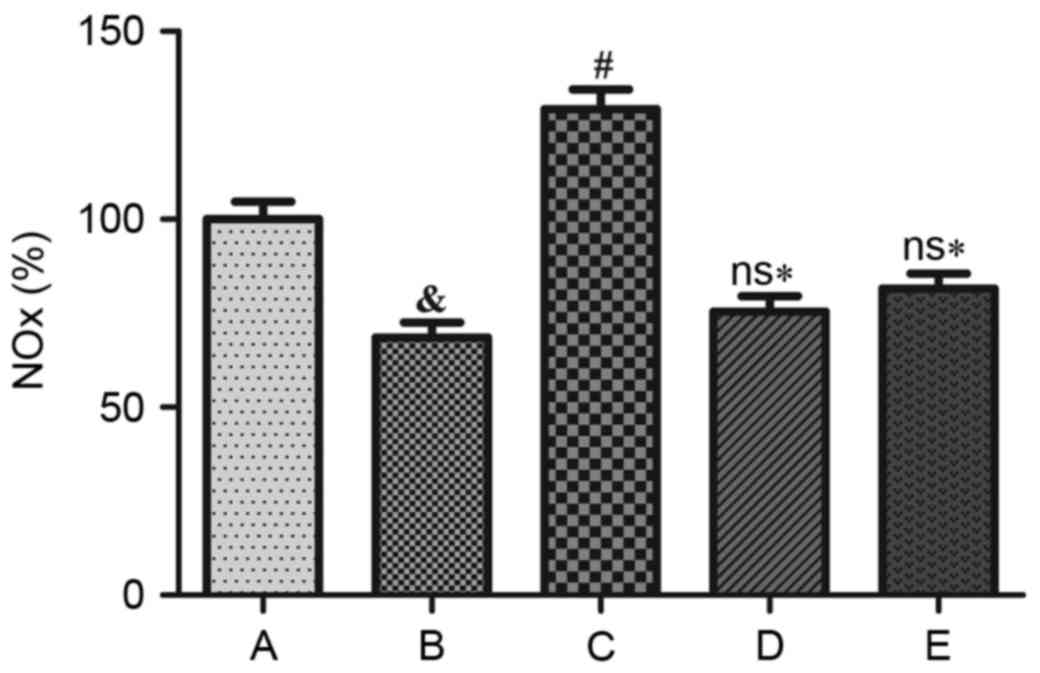Hydrogen sulfide facilities production of nitric oxide via the Akt/endothelial nitric oxide synthases signaling pathway to protect human umbilical vein endothelial cells from injury by angiotensin II
- Authors:
- Published online on: August 22, 2017 https://doi.org/10.3892/mmr.2017.7328
- Pages: 6255-6261
Abstract
Introduction
Endothelial cell injury has been demonstrated to be linked with angiocardiopathy-associated diseases, including atherosclerosis, hypertension and diabetic vasculopathy (1). Angiotensin (Ang) II induces injuries of endothelial cells and exerts substantial effects on the renin-angiotensin-aldosterone system, which is closely associated with regulation of the above-mentioned cardiovascular diseases (2,3). Under the pressure of Ang II, production of certain defensive substances [such as nitric oxide (NO)] would be stimulated in endothelial cells (4). Up to now, however, the method by which endothelial cells initiate defense mechanisms against the injuries induced by Ang II remains unknown.
Numerous physiological functions, including those relevant to immune and cardiovascular systems, are mediated by the known gaseous messenger, hydrogen sulfide (H2S), which is endogenously generated by cystathionine β-synthase, which is highly expressed in the brain, and cystathionine γ-lyase (CSE), which is concentrated in the vasculature (5). Furthermore, as H2S may induce various vascular effects that are similar to NO, including angiogenesis and smooth vascular muscle relaxation, it is hypothesized that certain internal connections may be present between H2S and NO (6). Furthermore, inhibition of H2S exhibits negative impacts on angiogenesis in the case of ischemic myocardium, therefore, identifying the pro-angiogenic mechanism of H2S may serve as a promising strategy for treating myocardial disorders (7).
Additionally, sodium hydrosulfide (NaHS) treatment exerted a positive effect on Akt phosphorylation and such a positive effect depends on treatment dose and duration, indicating that Akt phosphorylation was induced by H2S (5). Another study demonstrates that H2S exhibits a stimulatory role in endothelial nitric oxide synthases (eNOS) phosphorylation via an Akt-dependent and p38 mitogen-activated protein kinases (MAPK) mechanism, indicating that increased generation of NO eventually triggers the corresponding stimulatory effects of H2S on angiogenesis (6). Thus, it is hypothesized that the Akt/eNOS signaling pathway may be investigated to elucidate whether the underlying Ang II-induced endothelial cell injury may be restored under certain circumstances.
Therefore, the aim of the present study was to evaluate whether H2S stimulates the release of NO for protecting human umbilical vein endothelial cells (HUVECs) against Ang II-induced injury and whether the underlying mechanism involves the Akt/eNOS signaling pathway.
Materials and methods
Culture and treatment of HUVECs
HUVECs [American Type Culture Collection (ATCC) CRL-1730; ATCC, Manassas, VA, USA) were seeded into six-well plates at a density of 105/ml. The cells were cultivated with Dulbecco's modified Eagle's medium (DMEM) containing 10% fetal bovine serum (Gibco; Thermo Fisher Scientific, Inc., Waltham, MA, USA), at 37°C for 24 h under an atmosphere of 5% CO2 (4). The HUVECs (1×105) were divided into five treatment groups as follows: Normal control, Ang II, Ang II + NaHS (H2S donor), Ang II + Akt inhibitors + NaHS, and Ang II + eNOS inhibitors + NaHS. HUVECs were treated with Sigma-Aldrich Ang II (1 µM; Merck KGaA, Darmstadt, Germany) for 48 h to induce injury, while the treatment with 100 µM NaHS (H2S donor) was for 30 min. Incubation of HUVECs with the Akt inhibitor, LY 294002 (10 µM) and the eNOS inhibitor, L-NAME (200 µM; Sigma-Aldrich; Merck KGaA), were for 1 h, as previously described (6).
Cell viability detection by 3-(4,5-dimethylthiazol-2-yl)-2, 5-diphenyltetrazolium bromide (MTT)
Cells were incubated at 37°C for 3 h with fresh medium containing 1 g/l MTT. The unbounded MTT was washed with PBS and the formazan product in the form of blue-violet crystalline was dissolved with dimethyl sulfoxide. Finally, cell viability was indirectly measured by enzyme-linked immunosorbent assay at a wave length of 570 nm, after removing the background absorbance at a wave length of 690 nm, as previously described (8).
Cell apoptosis detected by flow cytometry
HUVECs were digested with trypsin, separated by centrifugation (1,000 rpm for 5 min) and washed gently with PBS 3 times. Apoptosis was detected in accordance with the procedures of an Annexin V-allophycocyanin/propidium iodide (PI) apoptosis detection kit (Beyotime Institute of Biotechnology, Haimen, China). The cells (5×105) were re-suspended in Annexin V binding solution (195 µl) and incubated with Annexin V-fluorescein isothiocyanate (5 µl) and PI (10 µl) for 20 min in the dark at room temperature. Finally, the detection of apoptosis was performed using flow cytometry (Bio-Rad Laboratories, Inc.- Hercules, CA, USA), as previously described (4).
Cell migration detected by wound healing method
Hydroxyurea (5 mmol/l) was added to the cell culture medium to inhibit the proliferation of HUVECs. Scratches were made using a yellow pipette tip, and the cells were then washed twice using growth medium. Images were obtained before and 24 h after formation of the scratches, and the cell migration rate was calculated by measuring the loss area, as previously described (5).
Cell proliferation detected using the 5-bromo-2′-deoxyuridine (BrdU) incorporation method
Cells were counted using a Nikon Eclipse TS100 optical microscope (Nikon Corporation, Tokyo, Japan) and seeded in 96-well plates (1×104 cells/well) for 24 h. The serum-free medium was replaced and the cells were incubated overnight at 37°C. Cell proliferation was then detected by BrdU immunostaining (Beyotime Institute of Biotechnology) (6).
Cell adhesion measured by hematoxylin staining
The serum-starved endothelial cells (density, 5×104 cells/well) were seeded into 12-well plates that were coated with type I collagen (2 mg/ml) at 37°C for 30 min. The medium was aspirated and washed gently twice with PBS. Subsequently, 4% paraformaldehyde was used to fix the adherent cells. The cells were stained with hematoxylin and observed using a Nikon Eclipse TS100 optical microscope (Nikon Corporation), as previously described (5).
Observation of tubular structures with an artificial basement membrane
The 24-well plates were coated with matrigel (300 µl) at 37°C for 30 min. Then the treated cells (density, 5×104 cells/well) were seeded in 24-well plates at 37°C for 16 h. Microscopic images were obtained using a Nikon Eclipse TS100 optical microscope (Nikon Corporation), and the length of the capillary was measured using Image J software version 1.46 (National Institutes of Health, Bethesda, MD, USA) to evaluate the formation of tubular structures (5).
NO production detected using the Griess method
Cells were incubated with 4-amino-5-methylamino-2′,7′-difluorofluorescein (5 µM) at 37°C for 30 min. Subsequently, the unbound dye was washed in DMEM medium and replaced with fresh medium. The results were observed by fluorescence microscopy (6).
Western blot analysis
HUVECs were washed with pre-cooled PBS buffer 3 times and then lysed with lysis solution [0.5 M EDTA and 1 M Tris-Cl (pH 7.4)], sucrose (0.3 M) and protease inhibitors (Sigma-Aldrich; Merck KGaA). The mixture underwent ultrasound processing on ice 3 times, for 5–10 sec each time. Subsequently, the lysate was centrifuged at 13,400 × g at 4°C for 5 min, after which the supernatant was collected. Electrophoresis with 10% sodium dodecyl sulfate polyacrylamide gel electrophoresis was performed, using 50 µg protein, at 4°C for 1–2 h. After completion of electrophoresis, proteins were transferred to polyvinylidene fluoride membranes at 80 V for 1 h and incubated with primary antibodies at 4°C overnight. The antibodies were as follows: Phosphorylated eNOS (Ser1177; catalog no. 9570; 1:1,000), eNOS) catalog no. 5880; 1:1,000), phosphorylated Akt (S473; catalog no. 11962; 1:1,000) and Akt (catalog no. 2920; 1:1,000; Cell Signaling Technology, Inc., Danvers, MA, USA), anti-CSE (catalog no. 22219–1-AP; 1:5,000; ProteinTech Group, Inc., Chicago, IL, USA) and anti-β-actin (catalog no. A5441; 1:10,000; Sigma-Aldrich; Merck KGaA). Finally, the proteins were incubated with a secondary antibody conjugated to horse radish peroxidase (catalog no. A7289; 1:2,000; Sigma-Aldrich, Merck KGaA), and were then exposed to enhanced chemiluminescence (ECL) liquid. Data analysis was conducted following X-ray tableting, development and fixing (6).
Statistical analysis
The data were processed using GraphPad Prism version 5.0 software (GraphPad Software, Inc., La Jolla, CA, USA) for statistical analysis and were presented as the mean ± standard deviation. When data conformed to normal distribution, between-group comparisons of measurement data were performed using a two-tailed t-test; otherwise, the non-parametric Mann-Whitney test was applied. Analysis of variance and the non-parametric Kruskal-Wallis test were performed for comparisons between the 5 groups. Regarding enumeration data, the χ2 test was implemented to compare the groups. P<0.05 was considered to indicate a statistically significant difference.
Results
Effects of Ang II and H2S on cell viability of HUVECs
Compared with the control group, cell viability decreased following treatment with Ang II for 48 h (P<0.05). Additionally, the cell survival rate was significantly improved by treatment with NaHS (P<0.05). However, cell survival did not significantly increase when HUVECs were exposed to LY 294002 (Akt inhibitor) or L-NAME (eNOS inhibitor) prior to NaHS treatment, indicating that cell viability was significantly reduced (P<0.05) when compared with NaHS treatment (Fig. 1).
Effects of Ang II and H2S on cell apoptosis of HUVECs
Compared with the control group, cell apoptosis was significantly increased following Ang II treatment for 48 h (P<0.001). NaHS treatment significantly reduced the percentage of apoptotic cells induced by Ang II (P<0.001). However, NaHS treatment was ineffective following simultaneous treatment with LY 294002 (Akt inhibitor) or L-NAME (eNOS inhibitor; Fig. 2).
Effects of Ang II and H2S on cell migration rate of HUVECs
The cell migration rate dropped significantly following treatment with Ang II when compared with the control group (P<0.05). NaHS treatment significantly improved the cell migration rate (P<0.05), although it did not enhance the cell migration rate when HUVECs were concurrently treated with LY 294002 (Akt inhibitor) or L-NAME (eNOS inhibitor). Thus, the cell migration rates were significantly declined compared with NaHS treatment alone (P<0.05; Fig. 3).
Effects of Ang II and H2S on cell proliferation of HUVECs
Cell proliferation decreased significantly subsequent to Ang II treatment when compared with the control group (P<0.05). NaHS treatment significantly increased cell proliferation (P<0.001); however, NaHS did not significantly increase cell proliferation following pretreatment with LY 294002 (Akt inhibitor) or L-NAME (eNOS inhibitor; Fig. 4).
Cell adhesion ability of HUVECs
The hematoxylin staining results demonstrated that cell adhesion ability decreased significantly following Ang II treatment (P<0.05), and NaHS exposure significantly improved cell adhesion ability (P<0.05). NaHS was, however, unable to markedly increase cell adhesion ability following pretreatment with LY 294002 (Akt inhibitor) or L-NAME (eNOS inhibitor; Fig. 5).
Cell tube formation assay of HUVECs
Cell tube formation ability decreased significantly subsequent to treatment with Ang II, compared with the control group (P<0.05). NaHS treatment significantly increased the length of capillaries, implying that the tube formation of HUVECs was stimulated by H2S (P<0.05). Conversely, NaHS failed to significantly promote HUVECs to form tubular structures when exposed to LY 294002 (Akt inhibitor) or L-NAME (eNOS inhibitor). Consequently, their cell tube formation ability decreased significantly when compared with treatment with NaHS alone (P<0.05; Fig. 6).
Effects of H2S on Akt and eNOS phosphorylation in HUVECs, and NO production
Compared with the control group, intracellular phosphorylation of Akt was significantly reduced following Ang II treatment (P<0.05; Fig. 7). NaHS treatment may significantly reverse this effect (P<0.05); however, treatment with NaHS + LY 294002 did not promote Akt phosphorylation. Furthermore, Akt phosphorylation was significantly reduced when compared with NaHS treatment (P<0.05), although it was not inhibited following treatment with L-NAME + NaHS (P<0.05). With respect to NaHS treatment, Akt phosphorylation in HUVECs was not statistically significant (Fig. 7A and C). In addition, the intracellular eNOS phosphorylation level was significantly lower than the control group following Ang II treatment (P<0.05) and NaHS treatment significantly reversed this effect (P<0.05). NaHS cannot, however, stimulate eNOS phosphorylation following LY 294002 or L-NAME pretreatment. Furthermore, eNOS phosphorylation decreased significantly (P<0.05) compared with the NaHS alone treatment group (Fig. 7B and D). Compared with the control group, the intracellular NO release was significantly reduced following Ang II treatment (P<0.05) and NaHS treatment significantly reversed this effect (P<0.05). NaHS treatment did not promote NO production when LY29400 or L-NAME was added and NO generation was significantly reduced compared with the NaHS alone treatment group (P<0.05; Fig. 8).
Discussion
The endothelium that lines the inner surface of the entire vascular tree is responsible for cardiovascular homeostasis (9,10). Endothelial dysfunction may be detected in various cardiovascular diseases, and reflects pathophysiological changes in the phenotype and functions of ECs (9). Four major findings have been described in the current study, following treatment of a culture of HUVECs. Firstly, Ang II (1 µM) significantly decreased cell viability, migration, proliferation, adhesion and tube-like structure formation in HUVECs, whilst it significantly increased cell apoptosis. Secondly, Ang II treatment significantly reduced the phosphorylation levels of Akt and eNOS, and NO metabolite concentrations in the culture media. Furthermore, all of the Ang II-induced responses were prevented by NaHS, an external H2S donor. Finally, all protective effects caused by NaHS were sensitive to MLY 294002 and L-NAME, selective antagonists of Akt and eNOS, respectively.
The primary function of Ang II lies in the adaptive changes in blood pressure and vascular homeostasis via regulation of vascular tone, sympathetic nervous excitability and electrolyte/water balance (11). Ang II, originating in either blood circulation or locally secreted vascular walls, activates multiple intracellular signaling pathways via Ang II type 1 (AT1) and AT2 receptors, of which are widely expressed in ECs. Specifically, Ang II activates NAD (P) H oxidase with a consequent increment in the production of reactive oxygen species (ROS) (12). Hence, excessive Ang II triggers the imbalance of ROS metabolism, and thereby causes DNA damage, mitochondrial dysfunction, as well as endothelium injury within HUVECs (13). The viability of HUVECs will be reduced and the corresponding apoptosis ratio will rise once the above-mentioned cellular damage occurs (13). As the migratory capability of ECs is pivotal in the maintenance of vessel wall integrity, and the precondition of angiogenesis is a normal endothelial function (14), it is hypothesized that Ang II treatment may significantly reduce cell proliferation, adhesion and tube-like structure formation in HUVECs.
H2S, a gasotransmitter produced in ECs, may deter the progression of various cardiovascular diseases through molecular inhibition of vascular inflammation and reduction of ROS levels within ECs (10,15,16). When synthesis of H2S in HUVECs is suppressed, cell apoptosis is caused and thereby a series of endocellular reactions are depressed, including cell migration, proliferation and tube-like structure formation (16,17). Thus, certain Ang II-induced types of damage are, to a certain extent, prevented by NaHS, and the present experimental results confirm the findings.
NO, a vital endogenous vasodilator, is produced in ECs by eNOS, but its availability is impaired in various cardiovascular diseases (9). In addition, increasing evidence demosntrates that H2S may exert protective effects on the cardiovascular systems by adjusting NO synthesis and/or its functions (6,9,18,19). The production of NO in ECs is based on activation of a cascade of phosphorylation events, for example, actions relevant to p38 MAPK, Akt and eNOS (6,20). Previous studies have demonstrated that Ang II significantly inhibited NO synthesis in HUVECs by increasing the generation of ROS and sequentially inducing injury of ECs (12,21).
There were certain limitations of the present study. The experimental results were obtained in vitro, therefore in vivo experiments are required for further consolidation. Furthermore, whether there are time- or dosage-dependent effects of Ang II and NaHS treatment remains unknown, as only a single dose and intervention time was used. Ang II induces dysfunctions of HUVECs via reducing NO generation and H2S weakens this malfunction via promoting the Akt/eNOS signaling pathway. Initially, Ang II and H2S were linked via their association with NO in the present study, and the results may provide a novel research approach for treating endothelial dysfunctions.
In conclusion, the present study demonstrates that H2S promotes NO synthesis, which may counteract the damage caused by Ang II. Furthermore, via a systematic experimental design, the present study indicates that H2S weakens Ang II-induced EC dysfunction via regulation of the Akt/eNOS signaling pathway.
References
|
Li B, Zani A, Martin Z, Lee C, Zani-Ruttenstock E, Eaton S and Pierro A: Intestinal epithelial cell injury is rescued by hydrogen sulfide. J Pediatr Surg. 51:775–778. 2016. View Article : Google Scholar : PubMed/NCBI | |
|
Nakashima H, Suzuki H, Ohtsu H, Chao JY, Utsunomiya H, Frank GD and Eguchi S: Angiotensin II regulates vascular and endothelial dysfunction: Recent topics of Angiotensin II type-1 receptor signaling in the vasculature. Curr Vasc Pharmacol. 4:67–78. 2006. View Article : Google Scholar : PubMed/NCBI | |
|
Zhi Z, Pengfei Z, Xiaoyi T and Genshan M: Adiponectin ameliorates angiotensin II-induced vascular endothelial damage. Cell Stress Chaperones. 19:705–713. 2014. View Article : Google Scholar : PubMed/NCBI | |
|
Luo P, Zhang WF, Qian ZX, Xiao LF, Wang H, Zhu TT, Li F, Hu CP and Zhang Z: MiR-590-5p-meidated LOX-1 upregulation promotes Angiotensin II-induced endothelial cell apoptosis. Biochem Biophys Res Commun. 471:402–408. 2016. View Article : Google Scholar : PubMed/NCBI | |
|
Cai WJ, Wang MJ, Moore PK, Jin HM, Yao T and Zhu YC: The novel proangiogenic effect of hydrogen sulfide is dependent on Akt phosphorylation. Cardiovasc Res. 76:29–40. 2007. View Article : Google Scholar : PubMed/NCBI | |
|
Altaany Z, Yang G and Wang R: Crosstalk between hydrogen sulfide and nitric oxide in endothelial cells. J Cell Mol Med. 17:879–888. 2013. View Article : Google Scholar : PubMed/NCBI | |
|
Osipov RM, Robich MP, Feng J, Liu Y, Clements RT, Glazer HP, Sodha NR, Szabo C, Bianchi C and Sellke FW: Effect of hydrogen sulfide in a porcine model of myocardial ischemia-reperfusion: Comparison of different administration regimens and characterization of the cellular mechanisms of protection. J Cardiovasc Pharmacol. 54:287–297. 2009. View Article : Google Scholar : PubMed/NCBI | |
|
Marampon F, Gravina GL, Scarsella L, Festuccia C, Lovat F, Ciccarelli C, Zani BM, Polidoro L, Grassi D, Desideri G, et al: Angiotensin-converting-enzyme inhibition counteracts angiotensin II-mediated endothelial cell dysfunction by modulating the p38/SirT1 axis. J Hypertens. 31:1972–1983. 2013. View Article : Google Scholar : PubMed/NCBI | |
|
Altaany Z, Moccia F, Munaron L, Mancardi D and Wang R: Hydrogen sulfide and endothelial dysfunction: Relationship with nitric oxide. Curr Med Chem. 21:3646–3661. 2014. View Article : Google Scholar : PubMed/NCBI | |
|
Wang R, Szabo C, Ichinose F, Ahmed A, Whiteman M and Papapetropoulos A: The role of H2S bioavailability in endothelial dysfunction. Trends Pharmacol Sci. 36:568–578. 2015. View Article : Google Scholar : PubMed/NCBI | |
|
Kanaide H, Ichiki T, Nishimura J and Hirano K: Cellular mechanism of vasoconstriction induced by angiotensin II: It remains to be determined. Circ Res. 93:1015–1017. 2003. View Article : Google Scholar : PubMed/NCBI | |
|
Desideri G, Bravi MC, Tucci M, Croce G, Marinucci MC, Santucci A, Alesse E and Ferri C: Angiotensin II inhibits endothelial cell motility through an AT1-dependent oxidant-sensitive decrement of nitric oxide availability. Arterioscler Thromb Vasc Biol. 23:1218–1223. 2003. View Article : Google Scholar : PubMed/NCBI | |
|
Lu Y, Wang RH, Guo BB and Jia YP: Quercetin inhibits angiotensin II induced apoptosis via mitochondrial pathway in human umbilical vein endothelial cells. Eur Rev Med Pharmacol Sci. 20:1609–1616. 2016.PubMed/NCBI | |
|
Jang H, Oh MY, Kim YJ, Choi IY, Yang HS, Ryu WS, Lee SH and Yoon BW: Hydrogen sulfide treatment induces angiogenesis after cerebral ischemia. J Neurosci Res. 92:1520–1528. 2014. View Article : Google Scholar : PubMed/NCBI | |
|
Yang G and Wang R: H2S and blood vessels: An overview. Handb Exp Pharmacol. 230:85–110. 2015. View Article : Google Scholar : PubMed/NCBI | |
|
Wang MJ, Cai WJ and Zhu YC: Mechanisms of angiogenesis: Role of hydrogen sulphide. Clin Exp Pharmacol Physiol. 37:764–771. 2010. View Article : Google Scholar : PubMed/NCBI | |
|
Shen Y, Guo W, Wang Z, Zhang Y, Zhong L and Zhu Y: Protective effects of hydrogen sulfide in hypoxic human umbilical vein endothelial cells: A possible mitochondria-dependent pathway. Int J Mol Sci. 14:13093–13108. 2013. View Article : Google Scholar : PubMed/NCBI | |
|
Coletta C, Papapetropoulos A, Erdelyi K, Olah G, Módis K, Panopoulos P, Asimakopoulou A, Gerö D, Sharina I, Martin E and Szabo C: Hydrogen sulfide and nitric oxide are mutually dependent in the regulation of angiogenesis and endothelium-dependent vasorelaxation. Proc Natl Acad Sci USA. 109:9161–9166. 2012; View Article : Google Scholar : PubMed/NCBI | |
|
Go YM, Lee HR and Park H: H(2)S inhibits oscillatory shear stress-induced monocyte binding to endothelial cells via nitric oxide production. Mol Cells. 34:449–455. 2012. View Article : Google Scholar : PubMed/NCBI | |
|
Predmore BL, Julian D and Cardounel AJ: Hydrogen sulfide increases nitric oxide production from endothelial cells by an akt-dependent mechanism. Front Physiol. 2:1042011. View Article : Google Scholar : PubMed/NCBI | |
|
Liu H, Chen T, Li N, Wang S and Bu P: Role of SIRT3 in angiotensin II-induced human umbilical vein endothelial cells dysfunction. BMC Cardiovasc Disord. 15:812015. View Article : Google Scholar : PubMed/NCBI |



